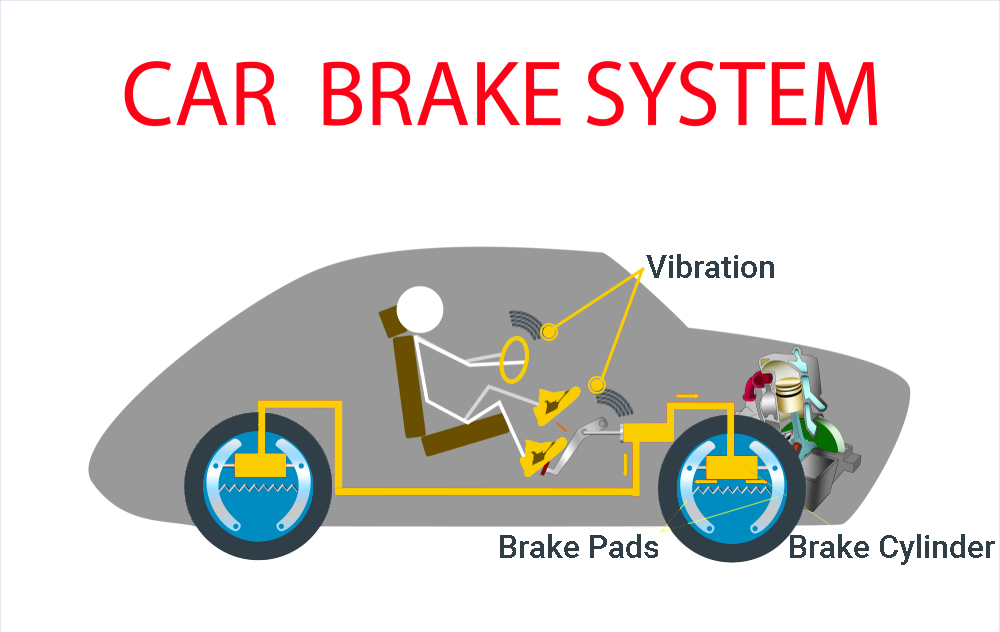Brake vibration is the vibration felt from the steering wheel and suspension when braking at certain speeds and pressures. It can range from a barely noticeable vibration to an intense vibration, felt in the brake pedal or steering wheel.

CAUSES AND SOLUTION
CAUSE 1: HUB AND/OR DISC WEAR

Brake vibration can occur when a poorly installed brake disc is misaligned with the hub or caliper.
There are some indicators and solutions to help you determine if this is the problem:
Check the hub for rust or dirt.
WHY IS THAT? Rust and dirt cause a weakening of the contact between the brake disc and the wheel hub.
SOLUTION: Remove the Brake Disc, clean both surfaces to remove dust and dirt.
Check that the hub surface is not worn by excessive tightening torque.
WHY IS THAT? In rare cases, the navels are curved. Screwing a brake disc into a bent hub will always cause brake vibration. Any rust on the hub surface will cause vibration if not cleaned before installing the Brake disc.
SOLUTION: After installing a brake disc, always check for disc wear using the dial indicator. If outside the wear tolerance, reinstall the disc in an alternate position until it is within the wear tolerance If the wear is still out of tolerance, the hub needs to be serviced.
Check if the wheels are mounted correctly
WHY IS THAT? One of the common causes of Brake Disc wear in recent years is the incorrect fitting of 'all size models' on alloy wheels. Because the same wheel is used for multiple hub types, installers use a positioning spacer on the wheel hoses. If the spacer is lost or damaged, the wheel cannot be properly centered.
SOLUTION: When installing the Brake Disc, place the wear gauge behind the disc and measure the wear. The scale indicates wear after the wheel has been installed and tightened and it may be necessary to replace the wheel.
Jantların doğru monte edilip edilmediğini kontrol edin
NEDEN? Fren Disk aşınmasının son yıllardaki yaygın nedenlerinden biri alaşımlı jantlara 'her ölçüye uygun modellerin' yanlış yerleştirilmesidir. Aynı tekerlek çok sayıda poyra tipi için kullanıldığından, yükleyenler teker hortumlarında konumlandırma ara parçası kullanırlar. Ara parça kaybolur veya hasar görürse, tekerlek doğru bir şekilde ortalanamaz.
ÇÖZÜM: Fren Diskini takarken aşınma ölçeğini diskin arkasına yerleştirin ve aşınmayı ölçün. Ölçek, teker takıldıktan ve sıkıldıktan sonra aşınmayı gösterir ve tekeri değiştirmek zorunlu olabilir.
CAUSE 2: SERIOUSLY OVERHEATING BRAKE DISC AND FAILURE
Any serious temperature rise can cause the disc metal in different parts of the Brake disc to deteriorate. These hot spots cause intermittent contact between pad and disc. This results in vibration. There are some indicators and solutions to help you determine if this is the problem:
Check if the brake is abused.
WHY IS THAT? Bad use of the brake is a common cause of overheating.
Brake Discs are designed to cool quickly between brake applications. However, if the brakes are applied heavily repeatedly, for example when driving in mountainous areas, the brake discs will not have enough time to dissipate the heat.
SOLUTION: Blue dots on the surface of the Brake Disc are a good indication of overheating. Discs in some sections with blue and/or darker dots cannot straighten and must always be replaced with the brake pads.
Check the quality of the brake pads.
WHY IS THAT? Low-quality brake pads can easily overheat, especially with heavy braking. Excessive heat in the pads can cause the brake discs to overheat, causing the brake discs to warp.
SOLUTION: Check again for a blue dot on the Brake Disc surface. If you can't find any blue dots, warn the driver about poor quality pads. Always replace brake pads and discs when you see blue dots on the disc.
CAUSE 3: BRAKE DISC THICKNESS CHANGE
Disc thickness variation is the difference in the thickness of the brake disc surface. If there is an uneven friction surface, the brake pad will loosen and re-contact with the disc(s) as it rotates. This causes brake vibration. There are some indicators and solutions to help you determine if this is the problem:
Ask the driver to see if the brakes are properly seated
WHY IS THAT? To get the best performance from your brakes, it is very important to follow the bearing installation procedure. By applying only moderate pressure during the first few applications of the brake pedal, a uniform layer of friction material is transferred from the pads to the brake disc. Mapping surfaces in this way increases safety and prevents friction associated with disc thickness variation.
SOLUTION: It's important to take precautions. Every time you install new brake pads, warn drivers to avoid braking hard for the first 200 km. If failure to seat properly has resulted in slight disc thickness variation, it may be sufficient to re-seat the brakes. If this does not bring the disc surfaces back into alignment, the only solution is to replace both the brake pads and brake discs. Yavuzsan has published a useful Driver and Technical support booklet for your convenience and to share with your customers.The booklet has a few tips and tricks on how to optimize their brake system. Consult your Yavuzsan representative for more information
Check caliper jam
WHY IS THAT? A seizing caliper piston or a seizing caliper slip pin causes uneven forces to be applied to each side of the brake disc, resulting in uneven wear or Disc thickness variation.
SOLUTION: This problem is usually caused by corrosion or dirt. Therefore, prevent a reoccurrence of the problem by properly maintaining a stuck caliper and replace both brake pads and brake discs
Check the disc surface for dirt or wear
WHY IS THAT? During braking, some of the vibration materials of the brake pad are transferred to the disc. With worse quality brake pads, residues of friction material adhere unevenly to the disc, changing the brake disc thickness and parallelism. If this does not bring the disc surfaces back into alignment, the only solution is to replace both the brake pads and the brake discs.
Check for pad marks on the Brake Discs
WHY IS THAT? Holding the brake pedal down when the brake overheats can leave a mark of pad material on the discs or weld. Disc thickness variation can usually be seen on the brake disc surface as the outline of a brake pad.
SOLUTION: It is normally sufficient to clean the pad mark using a brush or sandpaper.

